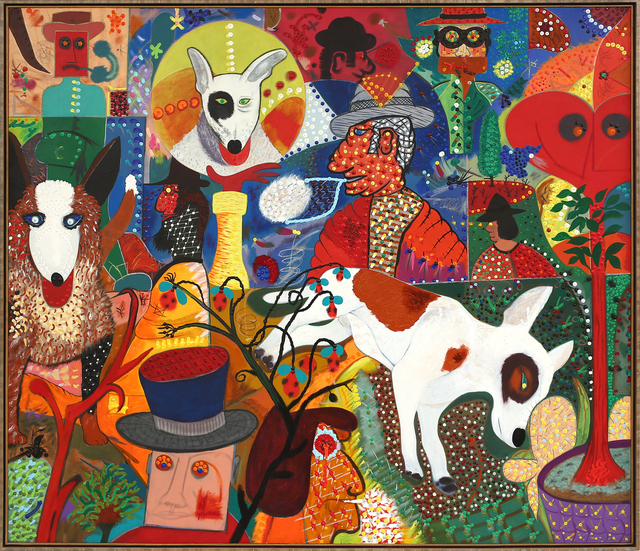
Roy de Forest
What a stunning find Mr. de Forest is. Walking through this exhibit is like taking a trip not on a synthetic psychedelic, but a desert, arid, hallucinogenic like peyote. Shamanistic is the best quintessential description I can find of his work here. It is a spiritual sojourn, yet without any brier patches which encumber the exploration like sticky molasses. There is no negative discharge associated with any of his ostensible imaginative tomfoolery. Yet each composition is magisterial in its moralistic effort at telling a tale, akin to the demarcation of an Amerindian myth. We see this bleedingly obvious with Baja Tales and A Black Dog, but all of his compositions here, which carry with it the sensation of baking hot sunsets with the mirages that can vaporize from heat exhaustion toward finding something transcendental about human experience, are fantastic in the fullest sense of the word.
The plasticity of the psychedelics is gentle and soft. It is not jarring to the vision of the subject which therefore does not perturb alarmingly. It is inviting, with child-like innocence and wonder, to be fully immersed in each fairy tale of hot vibrant colored punch. This elasticity is seen universally in his nonplussed consideration of a militant adherence to strict line compositions. They are wavy, be it large or small, because they are not what Mr. de Forest is making his art to serve. He is not studying technique, but again, telling a story. And each elaborate myth is so saturated with life! It is commendable in itself how independent his compositions are of the massive ephemeral art movements. It was as if he was a hermit exploring and meditating on human metaphysical significance, in-step with Kandinsky’s theory of a post-abstractionist progression, and this is what is revealed.
There is a lot of hand-waving here. When I say “metaphysical significance”, I mean grandiose outstretched imagery which taxes the human imagination, overpowering its accustomed sensations to create a meaning of awe. A true master can play with such complexity yet symbolize very elegantly. We can take a look at one of his pieces and may not understand every element’s purpose in serving the larger whole, but we can intuit, when looking at the bigger picture, some intentionality to the work. And how effortless it is to see the harmony in all of the intricacies is the work of genius! Even if the work happens to be basic rather than existential in provoking a self-examined inquiry, it is this exercise in challenging a subject’s ideation of conceivability, what he imagines what can possibly be-one of the prime tasks in art according to my art theory-, that Mr. de Forest triumphantly achieves.
He is surrealist without the quizzicality. He is interrogating without the condemning. He is psychedelic without the onanism.
What is his concentration if not obsession with the use of animals? Why, we may ask, did the Amerindians do the same in their narratives? The use of metaphor helps one to obtain a stronger grasp of objectivity, to rise above the taint of human passions and more specifically empathy in a narrative, enabling an easier reception of the symbolism attempted to be portrayed. True, most of the compositions may not leave one with a better comprehension of being human. To be critical yet poignant is a risky maneuver which too often is foolishly handled by inept artistry. But again, fine art is not the art form of philosophy. It is the art form of wonder. Of giving man a taste of The Good and then an addiction and craving to the tasting again. From this ostensibly humble yet realistically serious task within human culture, Mr. de Forest is exemplary.

